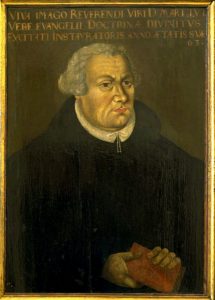  Oil paintings of Martin Luther and Philipp Melanchton. Oil paintings of Martin Luther and Philipp Melanchton.
Two oil paintings painted on wood, depicting two chief characters of Protestant Reformation. The paintings were probably painted in the 19th century, they are deposited in the painting gallery of the Museum of Protestantism. |
|
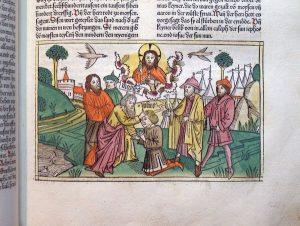 Biblia, Nürnberg 1483 Biblia, Nürnberg 1483
Dwutomowa Biblia, wydana w 1483 r. w Norymberdze w oficynie Antoniego Kobergera, wybitnego niemieckiego drukarza, wydawcy i księgarza, jest jednym z najstarszych dzieł drukowanych znajdujących się w Bibliotece i Archiwum im. Tschammera. Została ozdobiona licznymi, ręcznie kolorowanymi, drzeworytowymi ilustracjami, które Antoni Koberger przejął z tzw. Biblii kolońskiej wydrukowanej w 1478 r. przez Heinricha Quentella w Kolonii.
|
|
 Holy Bible, Nuremberg 1483 Holy Bible, Nuremberg 1483
This two-volume Bible, published by Anton Koberger in 1483 in Nuremberg, is one of the oldest printed works in the Tschammer Library and Archives. It is decorated with numerous hand-painted, wood-engraved illustrations.
|
|
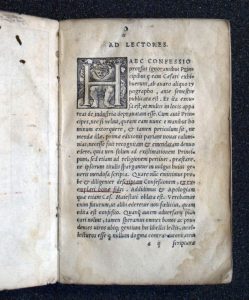 Philipp Melanchton, Confessio fidei exhibita invictiss. imp. Carolo V. Caesari Aug. in comicijs Augustae anno M.D.XXX. Addita est Apologia Confessionis…, Witebergae 1531 Philipp Melanchton, Confessio fidei exhibita invictiss. imp. Carolo V. Caesari Aug. in comicijs Augustae anno M.D.XXX. Addita est Apologia Confessionis…, Witebergae 1531
First Latin edition of the Augsburg Confession, printed in Wittenberg by Georg Rhau. Augsburg Confession contains basic doctrinal principles of the Reformation movement. They were written down by Philipp Melanchton and accepted by Martin Luther, then read during Augsburg Parliament meeting on June 25th 1530. The principles were also delivered to the Emperor Charles V and were designed to serve as the basis of the agreement between Catholics and Protestants, since they contain the demands and conditions of the agreement which were prepared by the Reformation party. As a reply, the Catholics prepared Roman Confutation, which was in turn disputed by Melanchthon’s Apology of the Augsburg Confession. Augsburg Confession, together with Apology, Small and Large Catechism, Smalcald Articles and Formula of Concord constitutes the six symbolical books containing the principal doctrines of Lutheranism.
|
|
 Martin Luther, Home Postil – sermons for Sunday Scriptures and Major Holidays, in Konigsberg, 1574 (Postilla domowa: to yest Kazania na ewangelie niedzielne y przednieysze swięta.., W Królewcu 1574) Martin Luther, Home Postil – sermons for Sunday Scriptures and Major Holidays, in Konigsberg, 1574 (Postilla domowa: to yest Kazania na ewangelie niedzielne y przednieysze swięta.., W Królewcu 1574)
First Polish translation of the Home Postil by Martin Luther, by Hieronim Malecki, printed by Jan Daubmann in Konigsberg in 1574. A collection of 64 sermons given by Luther between 1532 and 1534 on the occasion of ecclesiastical holidays. Luther’s friends and household members were the first receivers of these sermons. They were written down by Luther’s secretary, Veit Dietrich. First printed edition of the Postil comes from 1544.
|
|
 Andrzej Schönflissius, Christian Postil of the Holy Bible and the doctors of the church, gathered for the Sundays of the year, part one [in Lubcz] 1652. (Postylli chrześcijanskiey z Bibliej S. y doktorow kościelnych.. zebraney na niedziele doroczne część pierwsza, [Lubcz] 1652) Andrzej Schönflissius, Christian Postil of the Holy Bible and the doctors of the church, gathered for the Sundays of the year, part one [in Lubcz] 1652. (Postylli chrześcijanskiey z Bibliej S. y doktorow kościelnych.. zebraney na niedziele doroczne część pierwsza, [Lubcz] 1652)
A unique copy of the Christian Postil by Andreas Schönflissius, a minister from Vilnius, printed in 1652 by Jan Lange in Lubcz on Neman River. The print was adorned with copperplates by Vilnius artist, Konrad Götke, including the artist’s self-portrait and the crest of Toruń. At the moment in Polish collections there are only two copies of A. Schönflissius’ creation. One of them, which is in relatively good shape is contained in the collection of Tschammer Library and Archive, while the other one, heavily damaged is kept in the Kórnik Library.
|
|
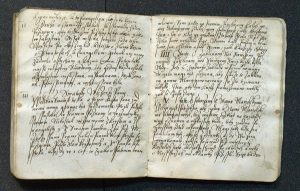 Church Order of Wenceslaus III Adam, 1568 Church Order of Wenceslaus III Adam, 1568
Duplicate of the first known Church Order of the Duke of Cieszyn, Wenceslaus III Adam from 1568 regulating the liturgical life of the Lutheran Church. The document was found by the renowned Cieszyn librarian, Jan Wantuła of Ustroń while ordering the Tschammer Library. Together with handwritten prayers and different notes it was sewn into the German Agenda printed in Nuremberg in 1569. The next Church Order was published by Wenceslaus Adam in 1578, accompanied with School Order. Subsequent regulation was published by his wife, Sidonia Katharina in 1578.
|
|
 Finial of the „Mercy Staff” Finial of the „Mercy Staff”
Habsburg Eagle which is the finial of the “Mercy Staff” which was used to appoint the construction site of the Jesus’ Church on 24th of May 1709 by the emissary of the Emperor Joseph I of Habsburg, Count Ludwig Zinzendorf, together with the governor of the duchy of Cieszyn, count Adam Wacław of Tenczyn.
|
|
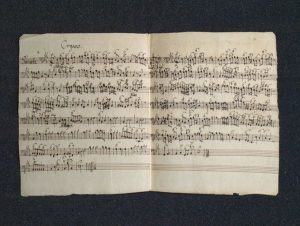 Sonatas of October 13th, 1710 Sonatas of October 13th, 1710
The collection of the archive includes a set of handwritten musical pieces, containing, among others two pieces comprising of instrumental sonata and an aria. The pieces had probably been prepared and presented while celebrating the fixing of corner stone of the Jesus’ Church in Cieszyn, on October 13th 1710.
|
|
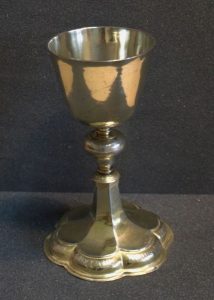 Liturgical Chalice of 1712 Liturgical Chalice of 1712
Liturgical chalice made of gilded silver, founded in 1712 by the count Juliusz Bogumił Sunnegk of Jesenice, is the oldest liturgical vessel stored in the Museum of Protestantism. Juliusz Bogumił Sunnegk, the owner of the Duchy of Bielsko supported the construction of the church and founded the parish building of that time.
|
|
 School Archive School Archive
The archive includes the collection of nearly 500 school notebooks, so called Probe-Schriften, containing the compositions of the pupils of evangelical school. The oldest of them – in the form of loose sheets of paper originate from the early 1740’s. Later, most of the compositions of the pupils, together with other works in cartography and drawing were stapled and bound, which is why they survived until present days in the form of the notebooks. The archive also contains numerous copies of Conduiten-Buch, which were a collection of notes about the pupils’ behaviour and condition, as well as grading books, school certificates and pupils’ record books with their grades and information about their progress.
|
|
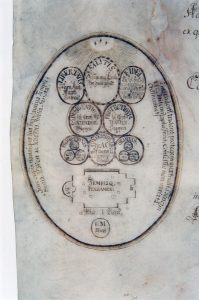 Jan Gotfryd Schuchardt, Commemoration of establishing and building of Jesus Church in Cieszyn, 1750 Jan Gotfryd Schuchardt, Commemoration of establishing and building of Jesus Church in Cieszyn, 1750
On the occasion of building Jesus Church in Cieszyn, there were three documents written on parchment. First of them, which was the proper deed of construction, was written by the reverend Jan Muthmann and added to silver chest with coins which was put on the cornerstone on October 13th 1710. Second document, which is located in Tschammer Library and Archive nowadays was made in 1750 by reverend and school inspector of that time, Jan Gottfryd Schuchardt for the celebration of completing the construction of the church tower. First page of this document is decorated with a drawing embedded in an oval shape. The drawing contains schematic representation of the church plan and nine rounded fields containing the names of the founders and superior priests of the parish. Apart from nearly fully repeated text of J. Muthmann’s manuscript, the document was supplemented with the history of the church construction from 1710 to 1750 and deposited in the wooden capsule which was in turn put into the barrel in the church tower. Third document, written by reverend Tobias Szubert was deposited in the tower in 1772.
|
 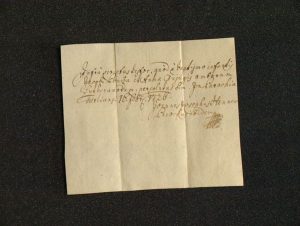  Archive closet of 18th century Archive closet of 18th century
Unique, wooden closet made of 15 drawers, each divided into four parts was intended to store so called szeduls which were a kind of letters of licence. These letters were issued for a fee by Catholic parsons to Evangelic reverends to give the agreement to perform the services of baptism, marriage or funeral. The legal situation changed only in January 1849, when the Evangelic priests ceased to pay the fee. The closet was probably fitted with some kind of superstructure, however, it is not possible to recreate it. It might have served as storage of other documents kept in the church archive. It is worth mentioning that this historic piece of furniture does not have any metal elements, all the joints and handles are made of wood. In 2009 the closet underwent thorough renovation.
|
|
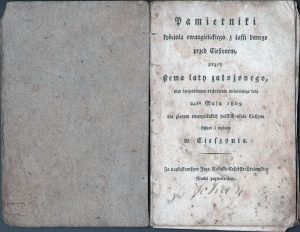 Jerzy Fryderyk Erdmann Klette of Klettenhoffu, Diaries of the Evangelical church given of God’s mercy near Cieszyn, established one hundred years ago, while piously celebrating the summer, 24th of May, 1809 (Pamiętniki kościoła ewangielickiego z łaski danego przed Cieszynem, przed stema laty założonego, przy świętobliwym obchodzeniu miłościwego lata 24go Maja 1809, Cieszyn 1809) Jerzy Fryderyk Erdmann Klette of Klettenhoffu, Diaries of the Evangelical church given of God’s mercy near Cieszyn, established one hundred years ago, while piously celebrating the summer, 24th of May, 1809 (Pamiętniki kościoła ewangielickiego z łaski danego przed Cieszynem, przed stema laty założonego, przy świętobliwym obchodzeniu miłościwego lata 24go Maja 1809, Cieszyn 1809)
First printed history of Jesus Church in Cieszyn, written by Jerzy Fryderyk Erdmann Klette of Klettenhof on the 100th anniversary of appointing the plot for the church construction. The work was published in 1809 in two language versions. German original was printed on the presses of Johan Georg Gastl in Brno, the anonymous polish translation was published by the efforts of Tomasz Prochaska in Cieszyn. It is the first print in Polish language of the oldest printing establishment in Cieszyn, and at the same time on of the oldest Cieszyn prints. Currently there are three known translations, two of them are located in Tschammer Library and Archive.
|
|
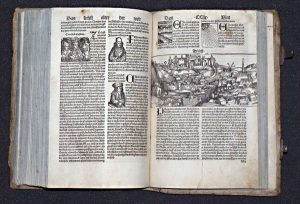 Hartmann Schedel, Liber chronicarum, Augsburg 1496 Hartmann Schedel, Liber chronicarum, Augsburg 1496
Liber chronicarum, or Nuremberg Chronicle by Hartmann Schedel is one of five incunables in Tschammer Library and Archive. Decorated with woodcut drawings from the atelier of Michael Wolgemut, issued in 1496 in Augsburg by Johann Schönsperger. The book is so called Little Schedel which is the abridged version of the work bearing the same title, issued in 1493 by Anton Koberger in Nuremberg. Since the illegal reprint of Schönsperger was printed on a low quality paper, the copies originating from this edition are very rare nowadays.
|
|
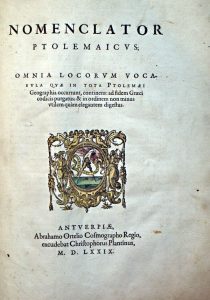 Abraham Ortelius, Theatrvm orbis terrarvm, Antverpiae 1579 Abraham Ortelius, Theatrvm orbis terrarvm, Antverpiae 1579
First contemporary world atlas made by Abraham Ortelius, Flemish geographer, cartographer and historian, published for the first time in 1570 in Antwerp. Until 1612 about 45 editions were published in many languages. In the subsequent editions of the atlas the maps had been updated and corrected, they were also decorated with the pictures of people, animals and sea creatures. Tschammer Library and Archive houses the issue with the author’s portrait published in 1579, printed in Antwerp by Christopher Plantin, containing the first map of Silesia by Martin Helwig of 1561
|
|
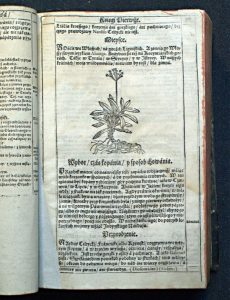 Szymon Syreński, Herbarium, that is the description of names, shapes and powers of herbs , in Cracow, 1613 (Szymon Syreński, Zielnik herbarzem z ięzyka łacińskiego zowią: to iest opisanie własne imion, kształtu… y mocy zioł…, w Krakowie 1613) Szymon Syreński, Herbarium, that is the description of names, shapes and powers of herbs , in Cracow, 1613 (Szymon Syreński, Zielnik herbarzem z ięzyka łacińskiego zowią: to iest opisanie własne imion, kształtu… y mocy zioł…, w Krakowie 1613)
The work of a renowned Polish doctor and botanist, Szymon Syreński containing the information about the most important species of plants known and used in Central and Southern Europe in 16th century is the first science book on botanics in Polish language. S. Syreński described 765 species of plants, listed their Polish, German and Latin names. Most of the species is accompanied with a woodcut drawing showing the plant in bloom with the roots. He also provided information about the locations where the plants grow, recommended picking time, medical properties and usage in the household and folk rituals. Between 1610 and 1611 Syreniusz started to publish the herbarium on his own in Cracow printing house of Mikołaj Lob. While the book was printed the author died and the printer stopped his work demanding to be paid. Finally, thanks to donation from Anna Vasa, the work was printed by Cracow printer Bazyli Skalski in March of 1613.
|
|
 Collection of maps from 18th century Collection of maps from 18th century
The archive also hosts the collection of 50 hand-coloured copperplate maps from 18th century. Most of the maps show the countries of Europe: England, Sweden, Germany, France, Switzerland, Bohemia, Austria, Hungary and Italy. There are also maps of single principalities or geographic regions located in the aforementioned countries, and maps of some continents. Most of the maps was made by renowned German cartographers and chalcographers, like for example Jacob von Sandrart of Nuremberg, who was famous for making portraits and publishing numerous illustrated books. It is also worth to mention Johann Baptista Homann, the most distinguished German publisher of maps and atlases, who was connected with Nuremberg too, and his apprentice Matthäus Seutter, who started his own printing and publishing house in Augsburg in 1710.
|



















